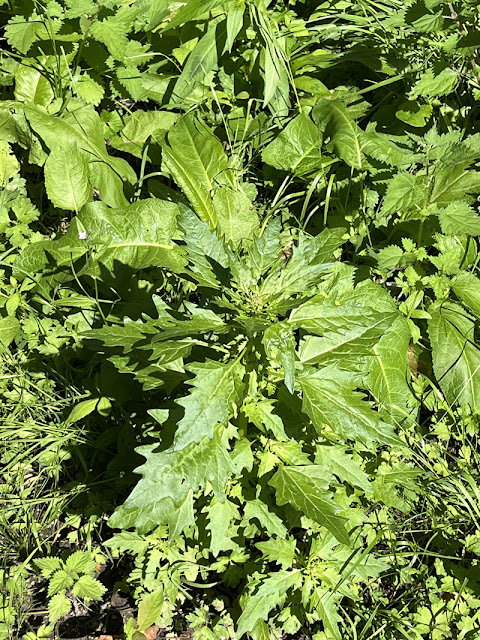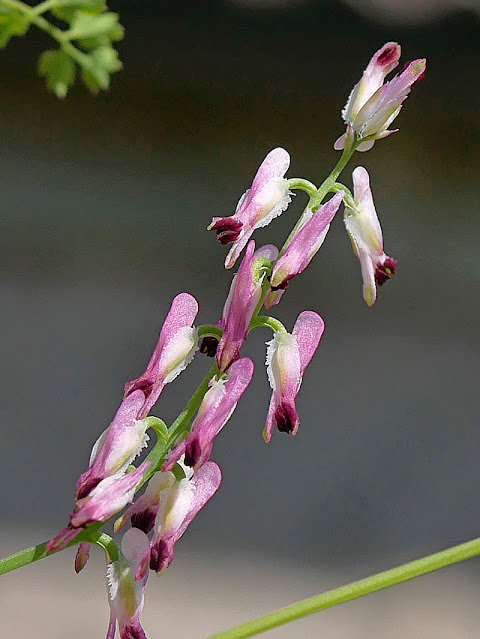Summer marches on and I can already feel Autumn coming as the evenings draw in, fruits appear in the hedgerows and grasses turn brown. Fortunately, we've had no prolonged hot, dry spells, so the plants have been getting rained on every few days keeping them fresher for longer. Below follows some of the interesting plants I've found so far this month.
It's still too early to determine most Oraches as they haven't yet developed their seed pods (bracteoles) which are diagnostic. However, one is easy to identify even when immature. It's Frosted Orache, so named as the leaves often appear frosted or silvery due to mealy hairs covering them. These wear off as they age, but the leaves are much smaller than other Oraches and it grows closest to the high tide mark than most too. This one was at Par Sands.
Atriplex laciniata
Sea Rocket is very common along many coasts and I would usually post a photo of its 4 petalled flowers, but the seed pods are just as interesting. They are buoyant and float off in the Autumn equinox tides to disperse to other areas. Taken at Par Sands.
Cakile maritima
August is the best month to identify Knotgrasses. At Par Sands, there are often good numbers of Sea Knotgrass, which is nationally scarce. It has leaves where the edges curl under; very short, crowded internodes, and much larger flowers than inland species.
Polygonum maritimum
I was lucky enough to also find Ray's Knotgrass at Par Sands. I hadn't found any in previous years, but this year there were quite a few. This was only the second time I had seen this species too. It's flowers are just as large as Sea Knotgrass and it grows in the same places, but the leaves do not curl under and there is a longer distance between the internodes. Its seeds also protrude somewhat from the sepals.
Polygonum oxyspermum subsp raii
Sea Spurge in full flower in the dunes, always close to the sea.
Euphorbia paralias
Most people don't even notice docks, or only do so when stung by a stinging nettle to rub in the stings (use Ribwort Plantain leaves for nettle stings they're much better). However, Curled Dock has three subspecies, the common inland form, a saltmarsh form and a sea or maritime form like below. It's found on beaches and areas close to salt influence. The notes in the photo tell you what to look for.
Rumex crispus subsp littoreus
Prickly Saltwort also grows at Par Sands and other sandy beaches, usually close to the higher tide marks. There are numerous plants ar Par, some quite large and bushy. As the name suggests, they are prickly. Being so close to the sea they don't bother with petals and just stick their "flower parts" out of a leaf node, much like Glassworts do, see below.
Salsola kali
In the tidal stream at the West end of Par Beach grew stands of Sea Club-rush with their distinctive clumps of spikelets.
Bolboschoenus maritimus
Growing with this Club-rush were several stands of Sea Aster. They look like Michaelmas Daisies, but these are native and only grow in saltmarsh. They're one of the few plants that have ray petals and which are routinely covered by high tides.
Tripolium pannonicum
Another new species for me at Par Sands, but back from the beach, was this Stinking Tutsan, a garden escape that is a medium tall shrub. The usual one to escape is the hybrid Tall Tutsan and they look very similar. The key thing to look for is that the sepals wither on the flower in Stinking and they don't on Tall. Also, as the name suggests, Stinking has an unpleasant smell when crushed and Tall is mildly pleasant, this last tip not being much use to me after several bouts of Covid reduced my sense of smell considerably. There's another species with "hirsinum" in its name and that's the Lizard Orchid, which smells of goat urine, so perhaps I'm glad I couldn't smell this one.
Hypericum hircinum
Tucked away behind the sandy dunes at Par is a small meadow which was awash with colour and different species of plants. The main one the photo shows is Purple Loosestrife.
Lythrum salicaria
In this meadow I also found a few Yellow Bartsia still flowering.
Parentucellia viscosa
Some Square-stalked St. John's-wort was here too.
Hypericum tetrapterum
In some bare sandy areas was Equal-leaved Knotgrass, easy to identify as the leaves on the main stem and branches are all roughly the same size. It grows flat to the ground too which is also diagnostic.
Polygonum depressum
Common Centaury flowering beautifully.
Centaurium erythraea
Common Valerian wasn't expected in dunes, but then some areas were quite damp, so it was obviously to their liking.
Valeriana officinalis
Another member of the dock Family caught my eye as it looks very distinctive in seed. It's Clustered Dock which has three tubercles on each bracteole (see inset photo) in whorls around the stem and leafy almost to the tip of the plant.
Rumex conglomeratus
Tansy was nearby with its peculiar button like flowers that lack ray petals entirely.
Tanacetum vulgare
I then left Par and drove a short distance to the Gribbin Head area. In a field edge on the way down to the sea I found some Chickory in flower.
Cichorium intybus
Also, a few Corn Marigolds, a relatively common sight in Cornwall's fields compared to the rest of the UK where one tends to only see them as arising from bird seed spillages.
Glebionis segetum
In the same field was a stunning leaf variant of White Clover, the best I've yet seen. There's around 12 leaf marking variants in total, but I rarely see any other than the standard chevron type.
Trifolium repens
My final plant for this day was the Narrow-leaved Everlasting Pea, a native plant, usually only found in coastal areas. It's leaves are very long compared to width and not fat and dumpy like the common garden escaped Broad-leaved species. It's flowers are also paler and not as showy as the garden form.
Lathyrus sylvestris
Most of the week I am not actively botanising but ferrying the family around shops. Whilst they go in shopping I often have a look around the car park and adjoining areas to see what I might find. A newly built store in Bodmin, thus with highly disturbed soil around its perimeter had this lovely Nettle-leaved Goosefoot growing. Unlike other Goosefoots, it has broad, shiny leaves with clearly defined teeth along the margins. Certainly a surprise find.
Chenopodiastrum murale
The next day I came across a Lesser Quaking Grass in seed in a Lidl car park in Wadebridge. A first record for the area. I was surprised how tall this plant was as I had only seen them in arable fields in Cornwall which were quite small.
Briza minor
A hybrid between Apple and Spear Mint found in a rural lay-by where it probably originated from dumped garden waste years ago. It had spread for around 10m of road verge.
Mentha x villosa
That round off my selection of plants found in early August, I hope you liked them.
Take care
Dave
























































